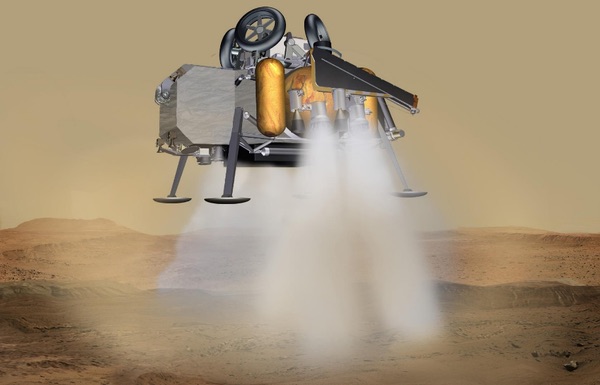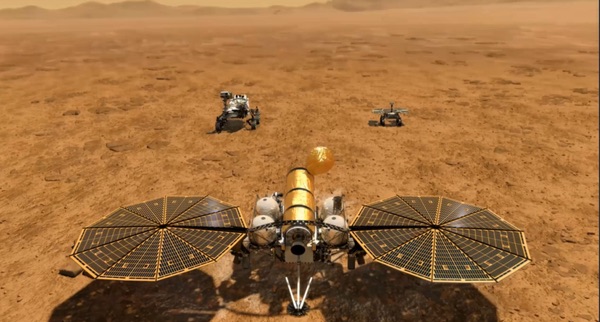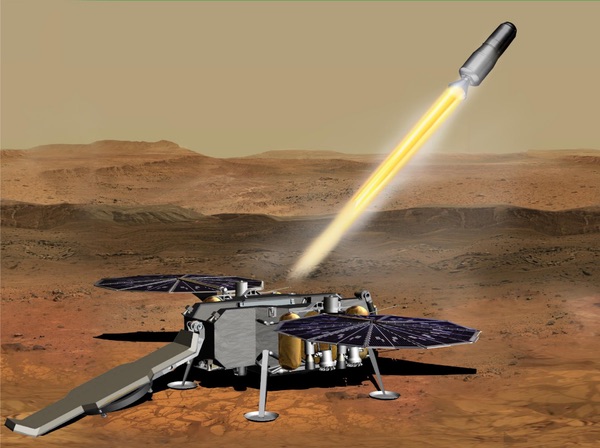Taking on the challenge of Mars sample returnby Jeff Foust
|
| While a lot of work remains to design and build the spacecraft that will return samples to Earth, the meeting offered the most detailed public discussion yet about how it will work. |
NASA announced its intent in August 2017 to pursue a “lean” sample return strategy in an effort to minimize the complexity, and cost, of getting samples back (see “Turning a corner on Mars,” The Space Review, August 19, 2019). Since then, NASA and the European Space Agency have said they will collaborate on a Mars Sample Return program, but the agencies have elaborated little on that overall architecture.
At a meeting of the Mars Exploration Program Analysis Group (MEPAG) earlier this month, though, NASA started to fill in the details about how it and ESA envision carrying out a Mars Sample Return program. While a lot of work remains to design and build the spacecraft that will return samples to Earth, the meeting offered the most detailed public discussion yet about how it will work.
 The Sample Retrieval Lander arriving on Mars to collect samples cached by Mars 2020. (credit: NASA) |
26-26-31
The overall architecture remains the same. NASA’s Mars 2020 rover—still on schedule to launch in July despite the coronavirus pandemic—will collect samples, caching them into sample tubes. A NASA lander mission will then launch in 2026, carrying an ESA-built “fetch rover” that will collect those tubes and load them into a container on the lander’s Mars Ascent Vehicle, a rocket that will place that container into orbit around Mars. An ESA-built orbiter mission, with a NASA capture and containment system, will grab that container and return it to Earth.
“This architecture is the one that we call a ‘26-26-31’ architecture,” said Austin Nicholas of the Mars Program office at JPL during the MEPAG meeting. It’s so named because both the Sample Retrieval Lander and Earth Return Orbiter would launch in 2026, with the samples returned to Earth in 2031.
That is the preferred architecture, he said, for several reasons. The timing of the mission would allow the lander to avoid operating during winter at the Jezero Crater landing site as well as the annual global dust storm season. That allows the lander and rover to use solar power, rather than the radioisotope thermoelectric generator (RTG) that powers Mars 2020’s Perseverance rover. That timing is also favorable for the landing itself, maximizing the mass delivered to the surface. The orbiter will also be able to serve as the communications relay for the lander and rover in the event other orbiters are no longer in service. Finally, he said that the lander and rover can launch in 2026 on available launch vehicles “with robust margins.”
In that architecture, the Sample Retrieval Lander would launch first, in July 2026. It will fly an unusual “one-and-a-half-revolution” trajectory to Mars, landing about two years later. Nicholas said the lander will have an “extended divert” capability, allowing it to target a landing site, scouted in advance by the Mars 2020 rover, with an accuracy of just 20 meters.
The lander then deploys the rover to collect the samples. In past discussions about Mars sample return concepts, NASA has stated that samples will be placed in tubes that will then be deposited on the surface, leading to visions of the fetch rover following the tracks of Perseverance, the sample tubes like breadcrumbs.
NASA’s current approach is somewhat different. “The common misconception is that the tubes will be scattered,” Nicholas said. Instead, Mars 2020 will use a “depot” concept, which he described as a “reasonably small area” about 40 meters across where Perseverance will deposit the tubes. “This enables the fetch rover to go to a single area in the landing site, then pick up the tubes one after the other.”
| Once loaded onto the lander, the Mars Ascent Vehicle, a solid-fuel rocket, blasts off to place the container containing the samples into orbit. |
The rover would then return to the lander to load the tubes into a container. However, he said NASA is also considering having Perseverance deliver some of the sample tubes directly: rather than caching them in the depot, Perseverance would keep some of them on board and travel to the lander. A video shown at the meeting, illustrating the concept, showed both Perseverance and the smaller fetch rover approaching the lander.
As the rovers return the samples to the lander, the Earth Return Orbiter is standing by. The orbiter would launch in October 2026 and go into orbit around Mars about a year later. The orbiter, using its electric propulsion system, then “spirals down” to a low orbit around Mars by the time the lander arrives, enabling it to serve as a communications relay as it awaits the sample container.
NASA’s plan calls for the retrieval of the samples, and their loading onto a lander’s Mars Ascent Vehicle, to take no more than 13 months, or half a Martian year, timed to the ideal conditions required for the solar-powered lander and fetch rover to operate. Once loaded onto the lander, the Mars Ascent Vehicle, a solid-fuel rocket, blasts off to place the container containing the samples into orbit.
NASA had studied both solid and hybrid propellant options for the Mars Ascent Vehicle, but ultimately went with the solid fuel. “The key figure of merit in that decision was really the technological readiness” of the system, Nicholas said.
Another factor is the condition of the landing site. Jezero Crater “is considerably warmer than some of the other sites that were under consideration,” said Jim Watzin, director of the Mars Exploration Program at NASA Headquarters. “It moved us from potentially being out of the comfort zone, thermally, for solids back into the comfort zone.”
Once the sample container is in orbit, the orbiter will rendezvous with it and grapple it, moving it into a sterile module. The orbiter will use its electric propulsion system to then leave Mars orbit, arriving back to Earth in 2031. The samples, in an Earth return vehicle, will reenter and land in Utah.
 A video shown at the MEPAG meeting illustrated how both the Perseverance Mars rover (left) and the “fetch rover” flown on the Sample Retrieval Lander could both return samples to the lander. (credit: NASA) |
Martian street cred
If successful, the Mars Sample Return program will be the culmination of decades of planning and proposals driven by the argument that having even a small amount of Mars samples in labs on Earth will drive scientific advancements not possible with instruments sent on spacecraft to Mars.
“We have to look at the individual grains, we have to look at things that stick the grains together, we have to look at the things that may be associated with grains and the cementing material matrix, and for that we need sample return,” said Michael Meyer, chief scientist of NASA’s Mars Exploration Program. “That’s why it represents huge, orders of magnitude increase in our information about Mars.”
| “We’re not prepared to discuss that at this point in time,” Watzin said when asked about the cost of the overall program. |
But, even though the plan is taking shape, it’s not without its challenges. One long-term one is planetary protection. That has traditionally involved measures to sterilize spacecraft to avoid contaminating Mars, but Mars Sample Return now means considering what needs to be done to protect the Earth from any contamination from the returned samples, so-called “backwards” planetary protection.
“Only recently, with the reality of a Mars Sample Return project, have we started to revisit and think in depth about implementation of backwards planetary protection,” said Lisa Pratt, NASA’s planetary protection officer. The last time NASA seriously thought about backwards planetary protection, she noted at the MEPAG meeting, was during the Apollo program a half century ago.
Planning for the missions has already started thinking about what’s required to, in planetary protection parlance, “break the chain of contact” with the surface of Mars, such that Martian samples are kept separated from the Earth’s biosphere. “We’re proceeding with the development a multi-pronged, strategic approach” to backwards planetary protection, said Morgan Hendry of JPL at the MEPAG meeting.
There are still, though, a number of open issues about planetary protection for Mars Sample Return, including where the samples will go once they arrive on Earth. Meyer said no decision had been made yet on where the sample receiving facility will be located to store the samples and determine if they are safe to be distributed to scientists.
Another issue is just how much Mars Sample Return will cost. Both the Sample Retrieval Lander and Earth Return Orbiter are in their early, pre-formulation phases of development, Watzin said. A concept review and development milestone known as Key Decision Point (KDP) A are scheduled before the end of the current fiscal year.
“We’re not prepared to discuss that at this point in time,” Watzin said when asked at the MEPAG meeting for the cost of the overall program. “As we go forward into KDP-A, we’ll have to start talking about that. Towards the end of this fiscal year is when we’ll be ready to have that conversation.”
NASA’s fiscal year 2021 budget proposal does provide some hints. That budget request includes a line for “Mars Future Missions” for which the agency seeks $232.6 million in 2021 and a total of nearly $2.68 billion from 2021 through 2025. That doesn’t include the Mars 2020 mission, whose formulation and development alone—excluding operations—cost about $2.4 billion.
That budget line would cover work on future Mars Sample Return missions, but also a proposed Mars Ice Mapper orbiter that is not part of the sample return architecture and also scheduled for launch in 2026. However, in another presentation at the MEPAG meeting, Watzin emphasized the role international partnerships would play in the mission, such as Canada, which is proving the radar instrument that will be the primary scientific payload. That suggests that NASA will work to minimize the costs of that mission to devote its resources to sample return.
Watzin also noted that ESA, which funded work on Mars Sample Return at its ministerial meeting last November, has selected a prime contractor for the Earth Return Orbiter and that negotiations with that company are underway. He did not disclose the company, but another presentation at the MEPAG meeting identified the company as Airbus, which had previously won a study contract for the orbiter.
| “Another difference between Mars Sample Return and other science missions is that we have what I call a ‘binary-ish’ mission success,” Nichols said. The program is only successful if the samples make it back to Earth. |
Watzin and other NASA officials at the meeting didn’t overlook the fact that Mars Sample Return will be one of the most challenging efforts that the agency has attempted in its long history of robotic solar system exploration. Many things have to go right for samples to safely arrive on Earth in 2031.
“Another difference between Mars Sample Return and other science missions is that we have what I call a ‘binary-ish’ mission success,” Nichols said. The program is only successful if the samples make it back to Earth, compared to another science mission that might still be considered successful if one or more instruments fail.
Watzin, though, was confident in the chances Mars Sample Return can be successful, citing NASA’s long history with Mars orbiters, landers, and rovers. “We have been building our capabilities and our resume for the better part of 50 years,” he said. “I think we have built our cred and are ready to take this challenge on.”
Note: we are temporarily moderating all comments submitted to deal with a surge in spam.
